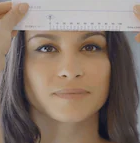On a typical prescription, you will see two sets of rows. Most of the time top portion is for your OD or right eye while the bottom portion is for your OS or left eye.
For Distance correction, there should always be a value under Sphere and most of the time it is negative. Its abbreviation is 'D.V.' which stands for Distance Vision.
For Reading-only correction, there should always be a value under sphere and most of the time it is positive. If there is a value under Near Vision (N.V., N.V.O.) then enter the power in the BOTTOM half of the form and leave the ADD power blank or ("0.00").
For astigmatism correction, please note that that Cylinder (CYL) and Axis are always provided together. For any value of Cylinder there should always be a value for Axis. Some doctors use positive (+) cylinder and some uses negative (-), there is a big difference between the two so please pay close attention to the positive and negative signs. If you don't have astigmatism correction, doctors might just leave it blank or simply SPH or DS which means Sphere or Diopters Sphere.
1.How to Measure Pupillary Distance.
 ... can show you how to measure it by yourself. PD, or pupillary distance, refers to the distance in millimeters between the center ...
... can show you how to measure it by yourself. PD, or pupillary distance, refers to the distance in millimeters between the center ...
2.About Frame.
Choosing the right pair of glasses for your needs can be enjoyable when you know what you are looking for. The first way to categorize frames is by their type. This describes how the frames interact with the lenses. There are five types: full-rimmed, rimless, semi-rimless, low bridge and wire.



